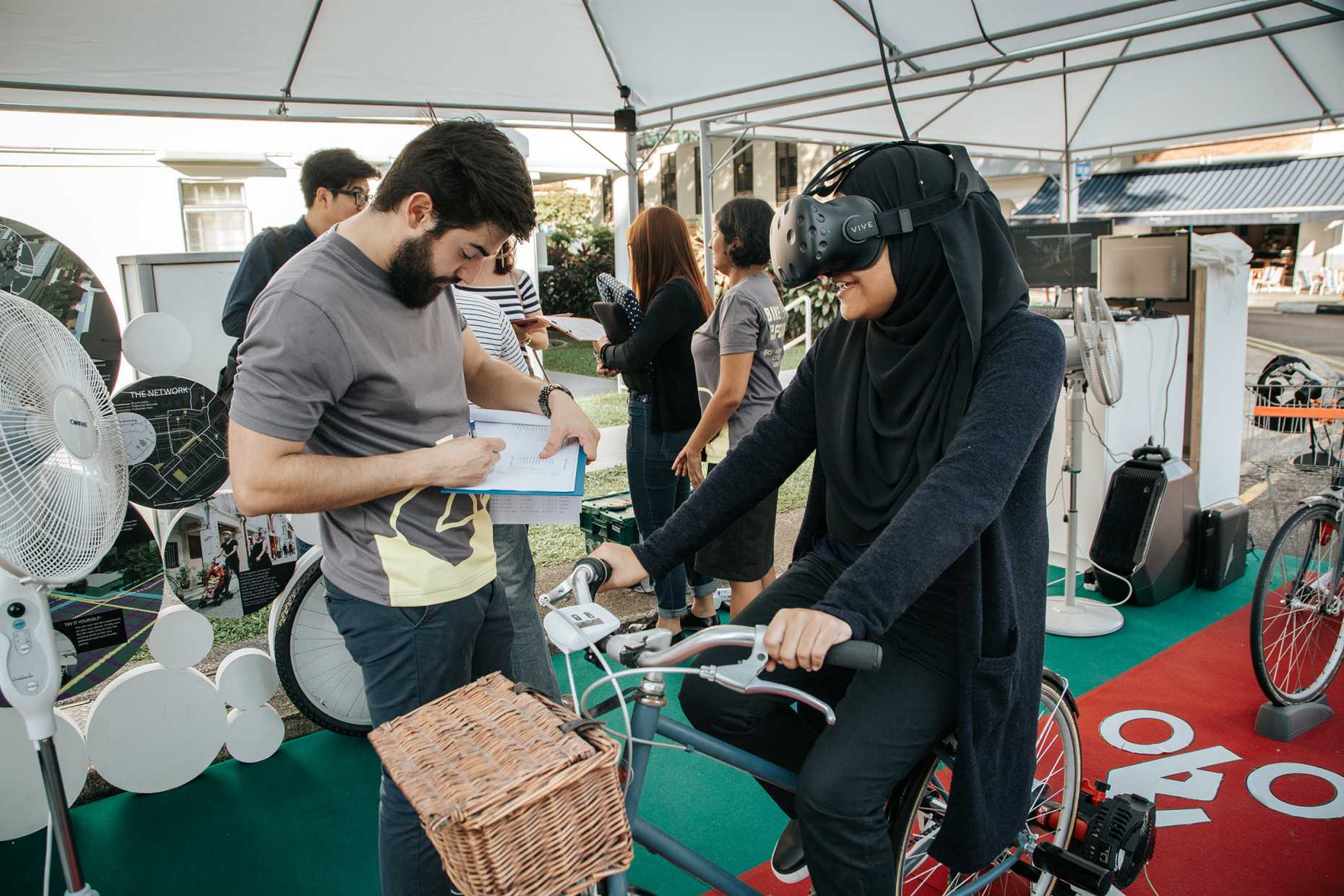Bike to the Future
Feb 2016 - Jan 2019
Understanding and evaluating behavioural reactions of cyclists to street design interventions.

Despite Singapore’s dense and polycentric urban structure the percentage of people who choose to cycle as a mode of transport is only about 1%. The lack of dedicated infrastructure to offer cyclists direct, safe, comfortable and attractive routes is widely considered to be the main reason for such a low modal share.
However, implementing new cycling infrastructure often requires heavy public investment and a trade-off for space with other transport modes. Therefore, it is important to understand the impact of different types of infrastructure and design options on travel behaviour before these infrastructural changes are implemented.
Planners, policy-makers and of course the public might not be familiar with these infrastructure and design options. To improve the understanding the options of different transport futures visualization plays an important role. Visualization is increasingly being used as a tool for understanding behavioural preferences and communicating plans to a general audience.
The advent of affordable and off-the-shelf virtual reality technology offers the opportunity to immerse people in an immersive transport future. Virtual reality offers unprecedented opportunities for communication and public engagement as it allows the user to immerse in and freely explore future environments. We aim to explore those opportunities by actively engaging the community to experience alternative design configurations in virtual reality and provide feedback both on the proposed plans but also the suitability of the VR technology as a research tool. Our current research in active mobility revolves around two core projects.
Bike to the Future
On World Parking Day (September 16, 2016) we engaged with the public and set t up a digital peephole into the future: Bike to the Future. We tested new possibilities for engaging people for street design and urban development projects. The technology combined the latest 3D modelling and traffic simulation techniques in virtual reality and showcased how streets can be re-designed to make cycling and walking a more pleasant experience. We reached over 300 people in four events and are in the process of evaluating survey results.
Bike to the Future 2
As the linchpin of this research project, we develop a virtual reality (VR) cycling simulator and explore how it can be used to study the impact of different types of infrastructure and design options on travel behaviour. To this end, we first will explore the validity of using such a simulator to study behavioural reactions while cycling and define practical applications.
In a next step, we test the simulator as a tool to provide evidence-based design guidance in pre-occupancy evaluation. This will ultimately enable transport engineers and urban designers to evaluate the impact of their plans on travel behaviour before the infrastructure is actually built.
Media
- external page call_made Hyde, John (2017). ‘Futuropolis’. Futurpolis.
- external page call_made Sim, Jay (2017). ‘Smart Cities 2.0’. Smart Cities 2.0.
- external page call_made The Straits Times (17 Sept 2016) Using virtual reality to get more people to cycle
- external page call_made Channel News Asia (5 Oct 2016) Using virtual reality to envision a car-lite future
Publications
- chevron_right Nazemi, M., van Eggermond, M. A., Erath, A., Schaffner, D., Joos, M., & Axhausen, K. W. (2018). Speed and space perception in virtual reality for bicycle research. In 7th International Cycling Safety Conference (ICSC 2018).
- chevron_right Nazemi, M., van Eggermond, M. A., Erath, A., & Axhausen, K. W. (2018). Studying cyclists’ behavior in a non-naturalistic experiment utilizing cycling simulator with immersive virtual reality. Arbeitsberichte Verkehrs-und Raumplanung, 1383.
- chevron_right Erath, Alexander, Tanvi Maheshwari, Michael Joos, Jonas Kupferschmid and Michael A. B. van Eggermond (2017). ‘Visualizing Transport Futures: The Potential of Integrating Procedural 3d Modelling and Traffic Micro-Simulation in Virtual Reality Applications for Transport Planning’, in 2017 Annual Meeting Compendium of Papers, paper presented at 96th Annual Meeting of the Transporationa Research Board, Washington D.C.
- chevron_right Maheshwari, Tanvi (2016). GASS, Singapore
- chevron_right KUPFERSCHMID, Jonas (2016). Using Vissim in Virtual Reality Applications to Evaluate Active Mobility Solutions, PTV Innovation Day, Singapore
- chevron_right Joos, Michael, Alexander Erath and Jonas Kupferschmid (2016). ‘Gussy up Vissim with the Rendering Power of a Game Engine’. Engaging Mobility Blog
Software
Any code developed as part of this project is published as Open Source software under a MIT license on the FCL Engaging Mobility repository on external page Github.